Exploring Spatial–Temporal Patterns of Air Pollution Concentration and Their Relationship with Land Use
Abstract
1. Introduction
2. Materials and Methods
2.1. Materials
2.2. Time-Series Analysis
2.3. Global Autocorrelation
2.4. Local Moran’s I Autocorrelation
2.5. Differences in Land Use
2.6. Statistical Analysis
3. Results
3.1. Time-Series Analysis
3.2. Global Autocorrelation
3.3. Local Autocorrelation
3.4. Land-Use Analysis
4. Discussion
5. Conclusions
Author Contributions
Funding
Institutional Review Board Statement
Informed Consent Statement
Data Availability Statement
Conflicts of Interest
References
- Mehmood, K.; Bao, Y.; Saifullah Cheng, W.; Khan, M.A.; Siddique, N.; Abrar, M.M.; Soban, A.; Fahad, S.; Naidu, R. Predicting the quality of air with machine learning approaches: Current research priorities and future perspectives. J. Clean. Prod. 2022, 379, 134656. [Google Scholar] [CrossRef]
- Wang, X.; Zhou, D. Spatial agglomeration and driving factors of environmental pollution: A spatial analysis. J. Clean. Prod. 2021, 279, 123839. [Google Scholar] [CrossRef]
- Hua, W.; Junfeng, Z.; Fubao, Z.; Weiwei, Z. Analysis of spatial pattern of aerosol optical depth and affecting factors using spatial autocorrelation and spatial autoregressive model. Environ. Earth Sci. 2016, 75, 822. [Google Scholar] [CrossRef]
- Ren, L.; Matsumoto, K. Effects of socioeconomic and natural factors on air pollution in China: A spatial panel data analysis. Sci. Total Environ. 2020, 740, 140155. [Google Scholar] [CrossRef] [PubMed]
- Habibi, R.; Alesheikh, A.A.; Mohammadinia, A.; Sharif, M. An assessment of spatial pattern characterization of air pollution: A case study of CO and PM2.5 in Tehran, Iran. ISPRS Int. J. Geo-Inf. 2017, 6, 270. [Google Scholar] [CrossRef]
- Gianquintieri, L.; Oxoli, D.; Caiani, E.G.; Brovelli, M.A. Land use influence on ambient PM2.5 and ammonia concentrations: Correlation analyses in the Lombardy region, Italy. AGILE GIScience Ser. 2023, 4, 26. [Google Scholar] [CrossRef]
- Gianquintieri, L.; Oxoli, D.; Caiani, E.G.; Brovelli, M.A. State-of-art in modelling particulate matter (PM) concentration: A scoping review of aims and methods. Environ. Dev. Sustain. 2024. Published online: 2 April 2024. [Google Scholar] [CrossRef]
- Park, Y.; Kim, S.H.; Kim, S.P.; Ryu, J.; Yi, J.; Kim, J.Y.; Yoon, H.J. Spatial autocorrelation may bias the risk estimation: An application of eigenvector spatial filtering on the risk of air pollutant on asthma. Sci. Total Environ. 2022, 843, 157053. [Google Scholar] [CrossRef] [PubMed]
- Molitor, J.; Jerrett, M.; Chang, C.C.; Molitor, N.T.; Gauderman, J.; Berhane, K.; McConnell, R.; Lurmann, F.; Wu, J.; Winer, A.; et al. Assessing uncertainty in spatial exposure models for air pollution health effects assessment. Environ. Health Perspect. 2007, 115, 1147–1153. [Google Scholar] [CrossRef]
- Mahakalkar, A.U.; Gianquintieri, L.; Amici, L.; Brovelli, M.A.; Caiani, E.G. Geospatial analysis of short-term exposure to air pollution and risk of cardiovascular diseases and mortality—A systematic review. Chemosphere 2024, 353, 141495. [Google Scholar] [CrossRef]
- Lee, D.; Mitchell, R. Controlling for localised spatio-temporal autocorrelation in long-term air pollution and health studies. Stat. Methods Med. Res. 2014, 23, 488–506. [Google Scholar] [CrossRef] [PubMed]
- Anselin, L. Local Indicators of Spatial Association—LISA. Geogr. Anal. 1995, 27, 93–115. [Google Scholar] [CrossRef]
- Anselin, L. A local indicator of multivariate spatial association: Extending Geary’s c. Geogr. Anal. 2019, 51, 133–150. [Google Scholar] [CrossRef]
- Getis, A.; Ord, J.K. The analysis of spatial association by use of distance statistics. Geogr. Anal. 1992, 24, 189–206. [Google Scholar] [CrossRef]
- Zhang, Y.; Wang, S.; Feng, Z.; Song, Y. Influenza incidence and air pollution: Findings from a four-year surveillance study of prefecture-level cities in China. Front. Public Health 2022, 10, 1071229. [Google Scholar] [CrossRef] [PubMed]
- Hoffmann, L.; Gilardi, L.; Schmitz, M.T.; Erbertseder, T.; Bittner, M.; Wüst, S.; Schmid, M.; Rittweger, J. Investigating the spatiotemporal associations between meteorological conditions and air pollution in the federal state Baden-Württemberg (Germany). Sci. Rep. 2024, 14, 5997. [Google Scholar] [CrossRef] [PubMed]
- Müller, I.; Erbertseder, T.; Taubenböck, H. Tropospheric NO2: Explorative analyses of spatial variability and impact factors. Remote Sens. Environ. 2022, 270, 112839. [Google Scholar] [CrossRef]
- European Environmental Agency. Air Quality in Europe—2019 Report; Report; European Environmental Agency: Copenhagen, Denmark, 2019.
- Gilardi, L.; Khorsandi, E.; Erbertseder, T. Global Air Pollution Data for Health Risk Assessments in Lombardy, Italy. In Proceedings of the 2023 Joint Urban Remote Sensing Event (JURSE), Heraklion, Greece, 17–19 May 2023. [Google Scholar] [CrossRef]
- Gilardi, L.; Marconcini, M.; Metz-Marconcini, A.; Esch, T.; Erbertseder, T. Long-term exposure and health risk assessment from air pollution: Impact of regional scale mobility. Int. J. Health Geogr. 2023, 22, 11. [Google Scholar] [CrossRef] [PubMed]
- Otto, P.; Fusta Moro, A.; Rodeschini, J.; Shaboviq, Q.; Ignaccolo, R.; Golini, N.; Cameletti, M.; Maranzano, P.; Finazzi, F.; Fassò, A. Spatiotemporal modelling of PM2.5 concentrations in Lombardy (Italy): A comparative study. Environ. Ecol. Stat. 2024, 31, 245–272. [Google Scholar] [CrossRef]
- Yu, X.; Shen, M.; Shen, W.; Zhang, X. Effects of land urbanization on smog pollution in China: Estimation of spatial autoregressive panel data models. Land 2020, 9, 337. [Google Scholar] [CrossRef]
- Huang, X.; Cai, Y.; Li, J. Evidence of the mitigated urban particulate matter island (UPI) effect in China during 2000-2015. Sci. Total Environ. 2019, 660, 1327–1337. [Google Scholar] [CrossRef] [PubMed]
- Li, J.; Gao, Y.; Huang, X. The impact of urban agglomeration on ozone precursor conditions: A systematic investigation across global agglomerations utilizing multi-source geospatial datasets. Sci. Total Environ. 2020, 704, 135458. [Google Scholar] [CrossRef] [PubMed]
- Rodríguez, M.C.; Dupont-Courtade, L.; Oueslati, W. Air pollution and urban structure linkages: Evidence from European cities. Renew. Sustain. Energy Rev. 2016, 53, 1–9. [Google Scholar] [CrossRef]
- Song, W.; Jia, H.; Li, Z.; Tang, D.; Wang, C. Detecting urban land-use configuration effects on O2 and NO variations using geographically weighted land use regression. Atmos. Environ. 2019, 197, 166–176. [Google Scholar] [CrossRef]
- Yuan, M.; Huang, Y.; Shen, H.; Li, T. Effects of urban form on haze pollution in China: Spatial regression analysis based on PM2.5 remote sensing data. Appl. Geogr. 2018, 98, 215–223. [Google Scholar] [CrossRef]
- Li, J.; Huang, X. Impact of land-cover layout on particulate matter 2.5 in urban areas of China. Int. J. Digit. Earth 2020, 13, 474–486. [Google Scholar] [CrossRef]
- Shi, Y.; Lau, K.K.-L.; Ng, E. Incorporating wind availability into land use regression modelling of air quality in mountainous high-density urban environment. Environ. Res. 2017, 157, 17–29. [Google Scholar] [CrossRef] [PubMed]
- Liu, Y.; Wu, J.; Yu, D.; Hao, R. Understanding the patterns and drivers of air pollution on multiple time scales: The case of northern China. Environ. Manag. 2018, 61, 1048–1061. [Google Scholar] [CrossRef]
- Xu, W.; Tian, Y.; Liu, Y.; Zhao, B.; Liu, Y.; Zhang, X. Understanding the spatial-temporal patterns and influential factors on air quality index: The case of North China. Int. J. Environ. Res. Public Health 2019, 16, 2820. [Google Scholar] [CrossRef]
- Zheng, Z.; Yang, Z.; Wu, Z.; Marinello, F. Spatial variation of NO2 and its impact factors in China: An application of sentinel-5P products. Remote Sens. 2019, 11, 1939. [Google Scholar] [CrossRef]
- Gianquintieri, L.; Oxoli, D.; Caiani, E.G.; Brovelli, M.A. Implementation of a GEOAI model to assess the impact of agricultural land on the spatial distribution of PM2.5 concentration. Chemosphere 2024, 352, 141438. [Google Scholar] [CrossRef] [PubMed]
- Gianquintieri, L.; Brovelli, M.A.; Pagliosa, A.; Bonora, R.; Sechi, G.M.; Caiani, E.G. Geospatial Correlation Analysis between Air Pollution Indicators and Estimated Speed of COVID-19 Diffusion in the Lombardy Region (Italy). Int. J. Environ. Res. Public Health 2021, 18, 12154. [Google Scholar] [CrossRef] [PubMed]
- Institut national de l‘environnement industriel et des risques (Ineris); Aarhus University; Norwegian Meteorological Institute (MET Norway); Jülich Institut für Energie- und Klimaforschung (IEK); Institute of Environmental Protection—National Re-search Institute (IEP-NRI); Koninklijk Nederlands Meteorologisch Instituut (KNMI); METEO FRANCE; Nederlandse Organi-satie voor toegepast-natuurwetenschappelijk onderzoek (TNO); Swedish Meteorological and Hydrological Institute (SMHI); Finnish Meteorological Institute (FMI); et al. CAMS European air quality forecasts, ENSEMBLE data. Copernicus Atmosphere Monitoring Service (CAMS) Atmosphere Data Store (ADS). 2022. Available online: https://ads.atmosphere.copernicus.eu/cdsapp#!/dataset/cams-europe-air-quality-reanalyses?tab=overview (accessed on 10 January 2024).
- Regione Lombardia. Uso e Copertura del Suolo 2021 (Dusaf 7.0); Regione Lombardia: Milan, Italy, 2021. [Google Scholar]
- Cleveland, R.B.; Cleveland, W.S.; McRae, J.E.; Terpenning, I. STL: A Seasonal-Trend Decomposition Procedure Based on Loess (with Discussion). J. Off. Stat. 1990, 6, 3–73. [Google Scholar]
- Griffith, D.A. Spatial Autocorrelation and Spatial Filtering. In Handbook of Regional Science; Springer: Berlin/Heidelberg, Germany, 2003. [Google Scholar] [CrossRef]
- Anselin, L.; Hudak, S. Spatial econometrics in practice. Reg. Sci. Urban Econ. 1992, 22, 509–536. [Google Scholar] [CrossRef]
- Rey, S.J.; Anselin, L. PySAL: A Python Library of Spatial Analytical Methods. Rev. Reg. Stud. 2007, 37, 5–27. [Google Scholar] [CrossRef]
- WHO Air Quality Guidelines. Available online: https://www.who.int/news-room/feature-stories/detail/what-are-the-who-air-quality-guidelines (accessed on 8 May 2024).
- Bao, J.; Yang, X.; Zhao, Z.; Wang, Z.; Yu, C.; Li, X. The spatial-temporal characteristics of air pollution in China from 2001–2014. Int. J. Environ. Res. Public Health 2015, 12, 15875–15887. [Google Scholar] [CrossRef] [PubMed]
- Liu, Y.; Tian, J.; Zheng, W.; Yin, L. Spatial and temporal distribution characteristics of haze and pollution particles in China based on spatial statistics. Urban Clim. 2022, 41, 101031. [Google Scholar] [CrossRef]
- Zheng, W.; Li, X.; Yin, L.; Wang, Y. Spatiotemporal heterogeneity of urban air pollution in China based on spatial analysis. Rend. Lincei 2016, 27, 351–356. [Google Scholar] [CrossRef]
- Cheng, Z.; Li, L.; Liu, J. Identifying the spatial effects and driving factors of urban PM2.5 pollution in China. Ecol. Indic. 2017, 82, 61–75. [Google Scholar] [CrossRef]
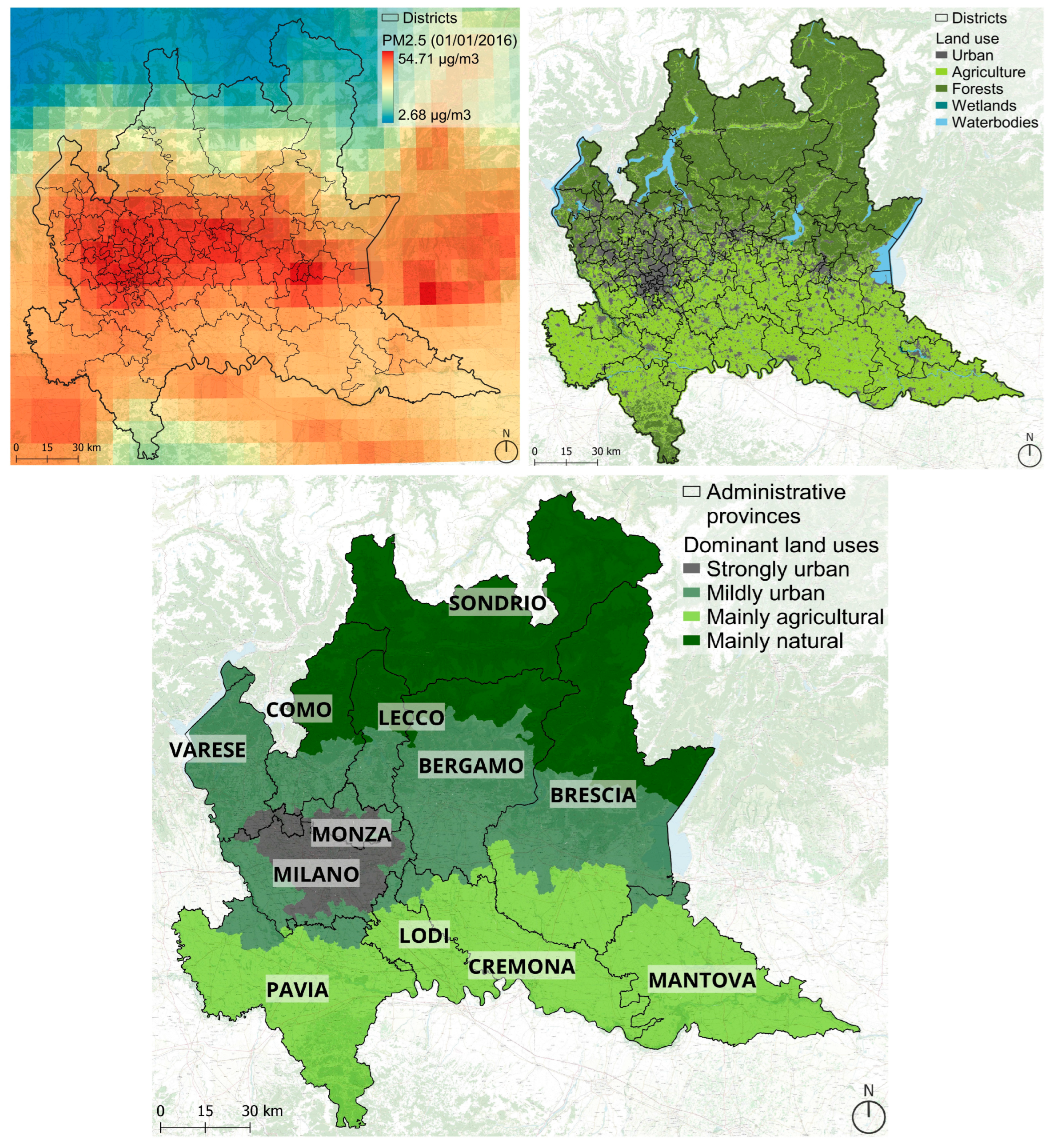
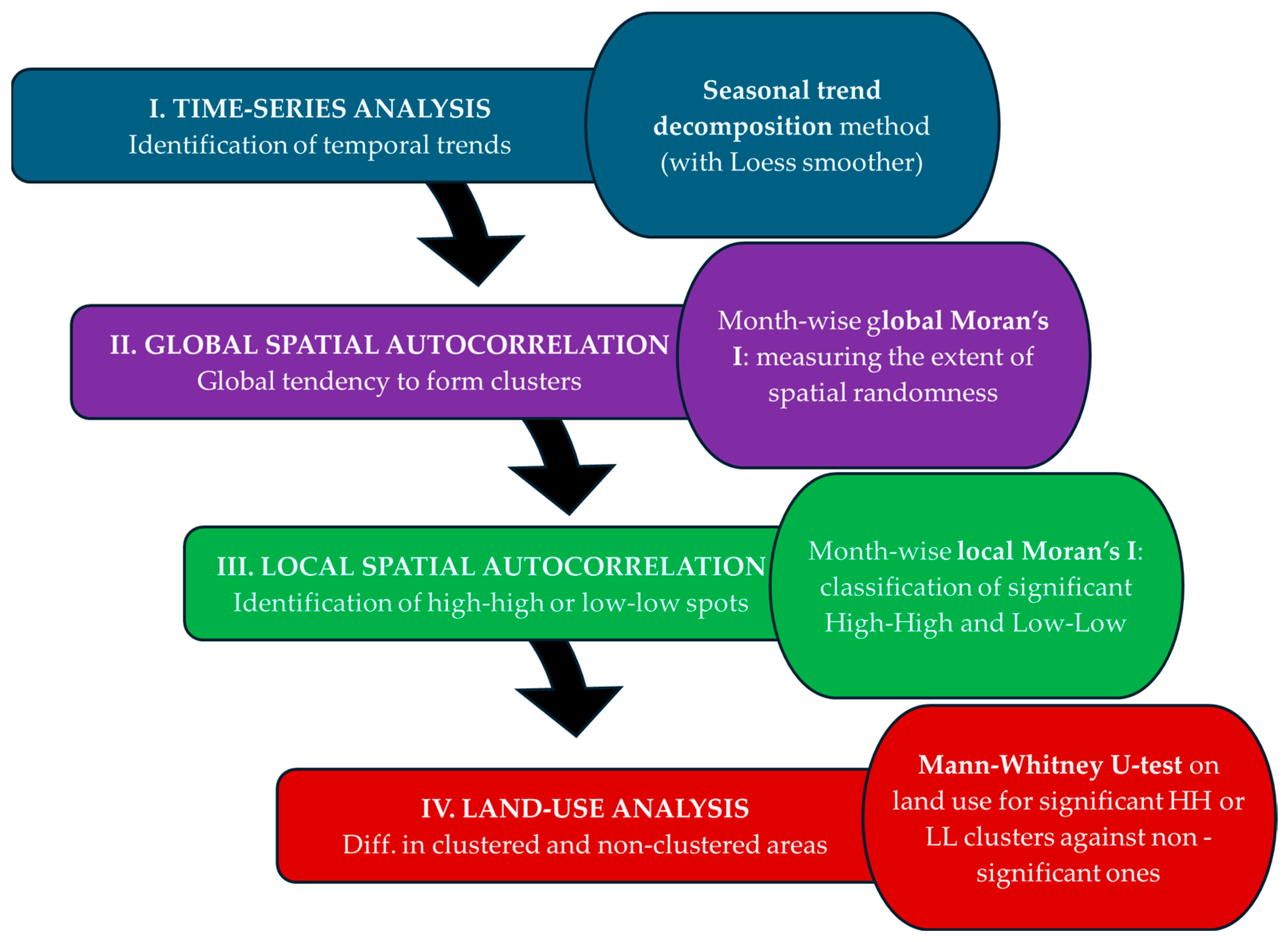
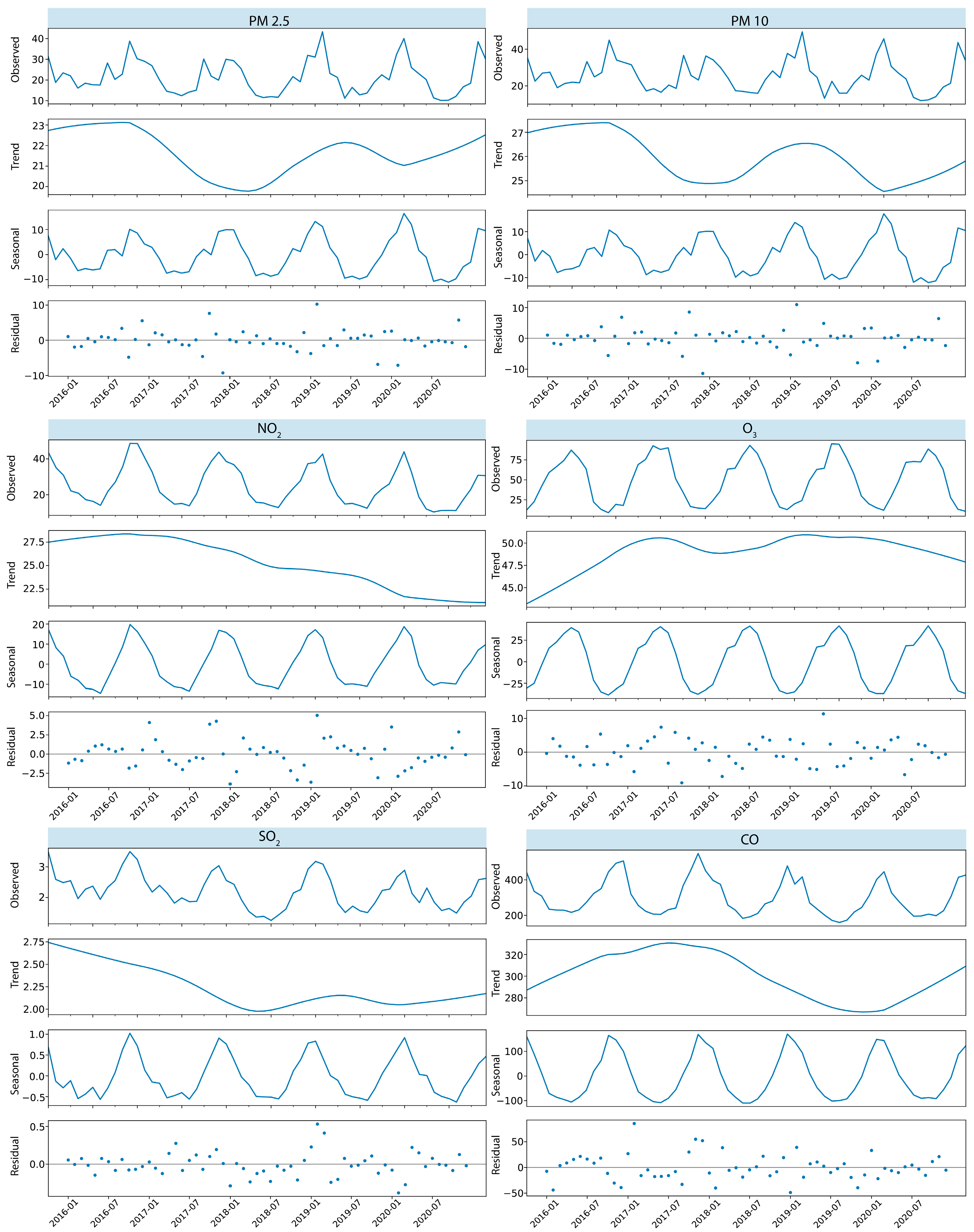
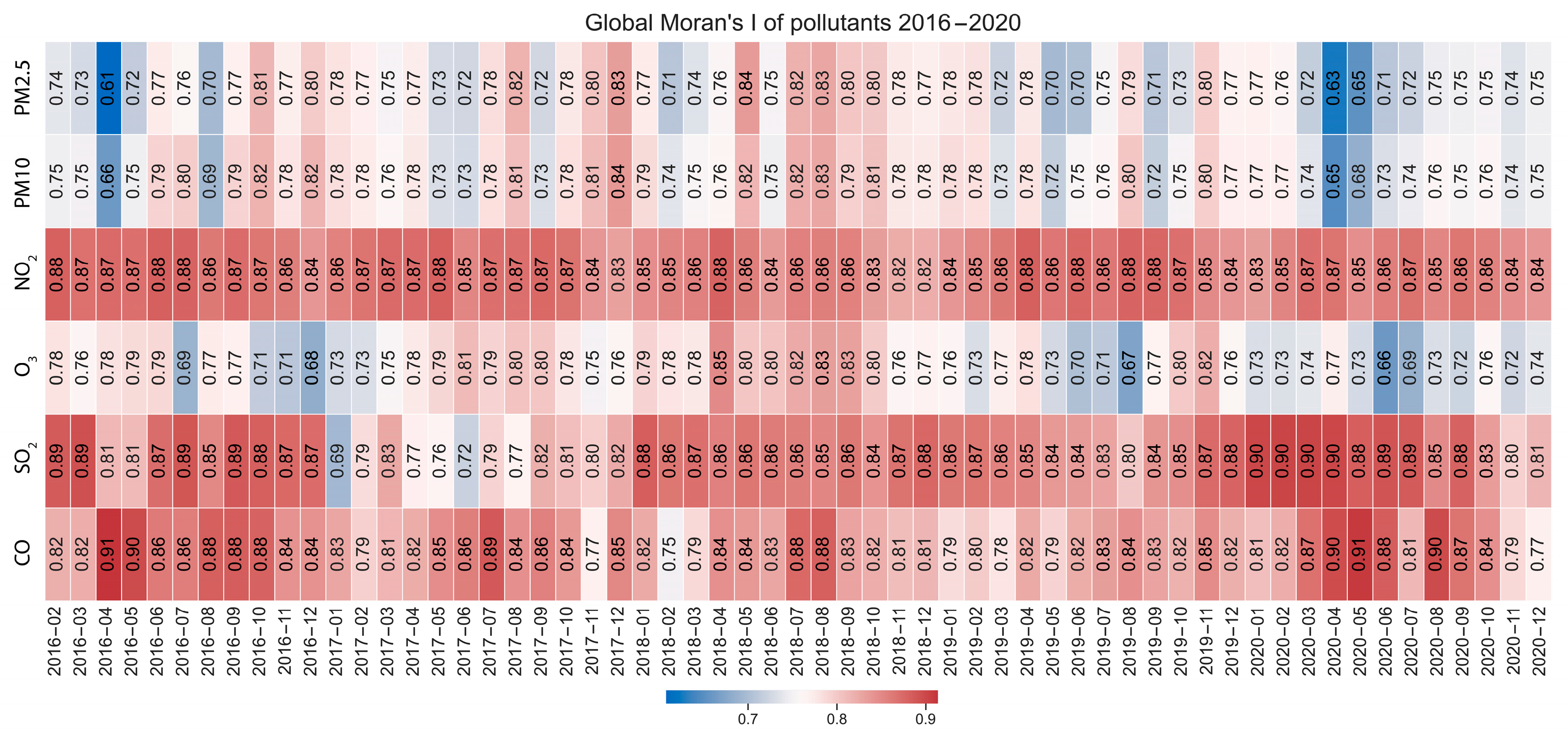
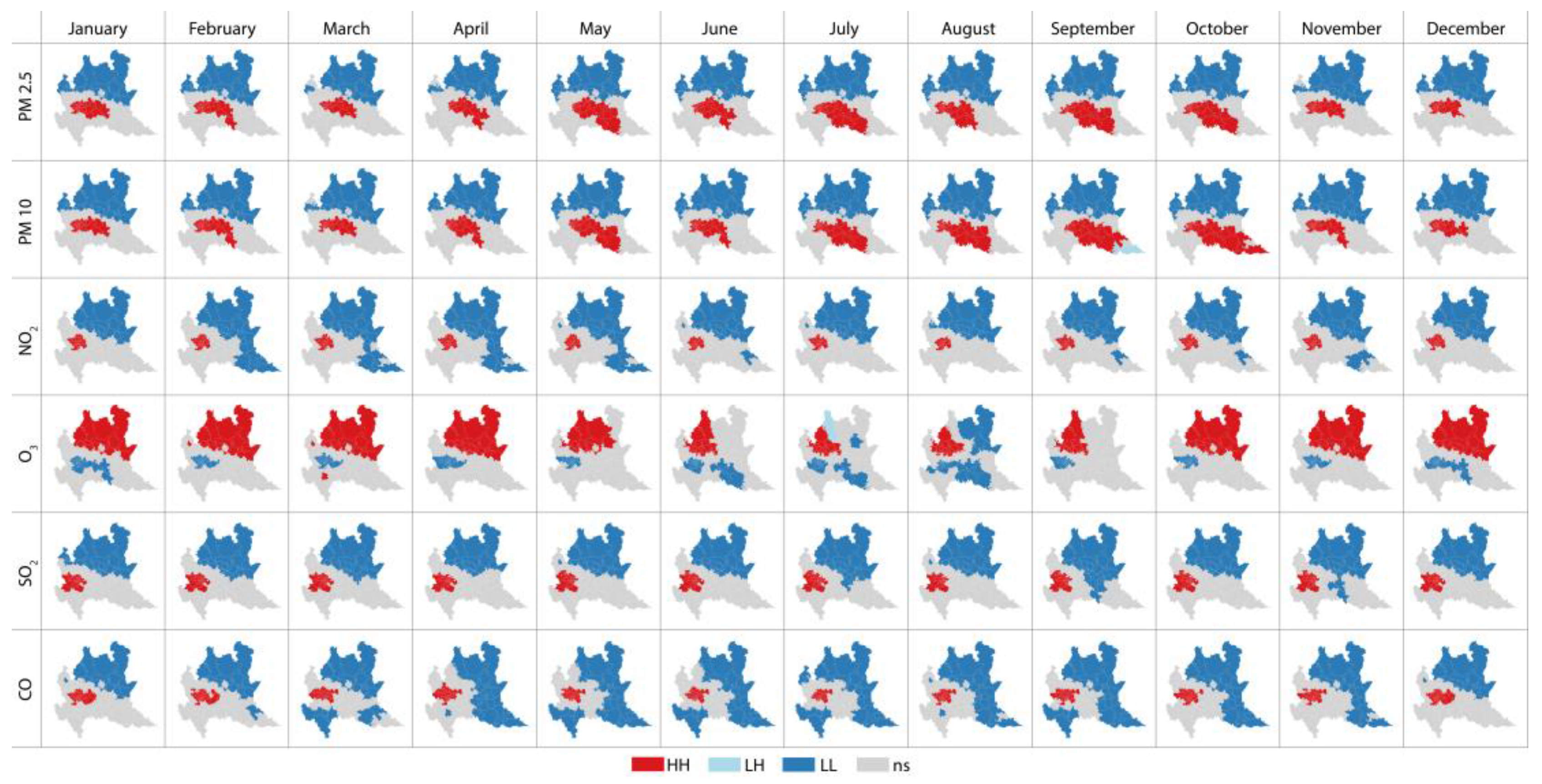
| PM2.5 | NO2 | PM10 | O3 | SO2 | CO | |
|---|---|---|---|---|---|---|
| WHO limit (µg/m3) | 15 | 25 | 45 | 100 | 40 | 4000 |
| Surpass days (%) | 61.69 | 42.42 | 11.22 | 5.04 | 0 | 0 |
| Mean | 21.41 | 25.05 | 25.66 | 49.26 | 2.22 | 299.65 |
| Median (25th–75th) |
17.88 (12.14–27.39) |
22.34 (14.9–33.43) |
22.24 (15.21–32.66) |
48.95 (19.2–74.39) |
2.11 (1.68–2.65) |
261.23 (211.51–365.91) |
| Maximum | 73.59 | 66.05 | 82.09 | 130.50 | 4.79 | 817.27 |
| Minimum | 3.01 | 6.04 | 3.86 | 3.49 | 0.58 | 120.53 |
| CO | High–High cluster | N = 992 (3.5%) | |
| Low–Low cluster | N = 9623 (33.9%) | ||
| Non clustered | N = 17,735 (62.6%) | ||
| High–High vs. Non clustered | Low–Low vs. Non clustered | ||
| Urban area | Distribution (HH) | 20.9 [5.6–42.4]% | 0.0 [0.0–1.0]% |
| Distribution (Nc) | 2.8 [0.6–10.0]% | 2.8 [0.6–10.0]% | |
| p–value | <0.01 | <0.01 | |
| Industrial and transport area | Distribution (HH) | 32.3 [14.9–49.9]% | 0.0 [0.0–0.2]% |
| Distribution (Nc) | 3.2 [0.2–10.4]% | 3.2 [0.2–10.4]% | |
| p–value | <0.01 | <0.01 | |
| Agricultural area | Distribution (HH) | 25.7 [5.1–54.3]% | 1.4 [0.0–13.1]% |
| Distribution (Nc) | 72.9 [25.6–91.1]% | 72.9 [25.6–91.1]% | |
| p–value | <0.01 | <0.01 | |
| Natural area | Distribution (HH) | 3.4 [0.8–8.6]% | 97.5 [81.0–100.0]% |
| Distribution (Nc) | 5.1 [0.6–33.6]% | 5.1 [0.6–33.6]% | |
| p–value | <0.01 | <0.01 | |
| NO2 | High–High cluster | N = 836 (2.9%) | |
| Low–Low cluster | N = 11,308 (39.9%) | ||
| Non clustered | N = 16,206 (57.2%) | ||
| High–High vs. Non clustered | Low–Low vs. Non clustered | ||
| Urban area | Distribution (HH) | 16.4 [3.6–38.5]% | 0.0 [0.0–1.7]% |
| Distribution (Nc) | 3.0 [0.7–10.6]% | 3.0 [0.7–10.6]% | |
| p–value | <0.01 | <0.01 | |
| Industrial and transport area | Distribution (HH) | 33.7 [12.0–52.9]% | 0.0 [0.0–0.4]% |
| Distribution (Nc) | 3.8 [0.5–11.4]% | 3.8 [0.5–11.4]% | |
| p–value | <0.01 | <0.01 | |
| Agricultural area | Distribution (HH) | 28.1 [3.4–66.4]% | 2.0 [0.0–14.7]% |
| Distribution (Nc) | 77.4 [36.8–91.8]% | 77.4 [36.8–91.8]% | |
| p–value | <0.01 | <0.01 | |
| Natural area | Distribution (HH) | 3.0 [0.4–7.2]% | 96.3 [78.0–100.0]% |
| Distribution (Nc) | 4.0 [0.4–19.3]% | 4.0 [0.4–19.3]% | |
| p–value | <0.01 | <0.01 | |
| O3 | High–High cluster | N = 1870 (6.6%) | |
| Low–Low cluster | N = 551 (1.9%) | ||
| Non clustered | N = 25,929 (91.5%) | ||
| High–High vs. Non clustered | Low–Low vs. Non clustered | ||
| Urban area | Distribution (HH) | 1.7 [0.0–12.4]% | 11.1 [2.5–29.7]% |
| Distribution (Nc) | 1.4 [0.0–6.7]% | 1.4 [0.0–6.7]% | |
| p–value | <0.01 | <0.01 | |
| Industrial and transport area | Distribution (HH) | 0.0 [0.0–2.8]% | 27.6 [7.3–51.1]% |
| Distribution (Nc) | 1.1 [0.0–7.5]% | 1.1 [0.0–7.5]% | |
| p–value | <0.01 | <0.01 | |
| Agricultural area | Distribution (HH) | 6.2 [0.5–17.0]% | 41.9 [5.5–79.4]% |
| Distribution (Nc) | 37.5 [3.3–85.1]% | 37.5 [3.3–85.1]% | |
| p–value | <0.01 | <0.01 | |
| Natural area | Distribution (HH) | 86.7 [61.7–98.3]% | 3.3 [0.4–7.7]% |
| Distribution (Nc) | 20.1 [1.9–93.0]% | 20.1 [1.9–93.0]% | |
| p–value | <0.01 | <0.01 | |
| PM2.5 | High–High cluster | N = 1969 (6.9%) | |
| Low–Low cluster | N = 10,688 (37.7%) | ||
| Non clustered | N = 15,693 (55.4%) | ||
| High–High vs. Non clustered | Low–Low vs. Non clustered | ||
| Urban area | Distribution (HH) | 2.8 [1.0–12.3]% | 0.0 [0.0–1.7]% |
| Distribution (Nc) | 3.0 [0.7–11.1]% | 3.0 [0.7–11.1]% | |
| p–value | 0.03 | <0.01 | |
| Industrial and transport area | Distribution (HH) | 7.3 [2.9–18.0]% | 0.0 [0.0–0.3]% |
| Distribution (Nc) | 3.5 [0.3–11.9]% | 3.5 [0.3–11.9]% | |
| p–value | <0.01 | <0.01 | |
| Agricultural area | Distribution (HH) | 80.7 [58.3–91.4]% | 1.7 [0.0–13.1]% |
| Distribution (Nc) | 73.1 [28.6–91.1]% | 73.1 [28.6–91.1]% | |
| p–value | <0.01 | <0.01 | |
| Natural area | Distribution (HH) | 1.8 [0.0–5.6]% | 96.7 [79.2–100.0]% |
| Distribution (Nc) | 4.6 [0.5–24.7]% | 4.6 [0.5–24.7]% | |
| p–value | <0.01 | <0.01 | |
| PM10 | High–High cluster | N = 1690 (6%) | |
| Low–Low cluster | N = 10,632 (37.5%) | ||
| Non clustered | N = 16,028 (56.5%) | ||
| High–High vs. Non clustered | Low–Low vs. Non clustered | ||
| Urban area | Distribution (HH) | 3.0 [1.0–14.5]% | 0.0 [0.0–1.6]% |
| Distribution (Nc) | 3.0 [0.7–11.1]% | 3.0 [0.7–11.1]% | |
| p–value | <0.01 | <0.01 | |
| Industrial and transport area | Distribution (HH) | 7.4 [2.9–21.7]% | 0.0 [0.0–0.3]% |
| Distribution (Nc) | 3.6 [0.3–12.0]% | 3.6 [0.3–12.0]% | |
| p–value | <0.01 | <0.01 | |
| Agricultural area | Distribution (HH) | 80.2 [51.7–91.4]% | 1.7 [0.0–13.1]% |
| Distribution (Nc) | 73.3 [29.3–91.1]% | 73.3 [29.3–91.1]% | |
| p–value | <0.01 | <0.01 | |
| Natural area | Distribution (HH) | 1.9 [0.0–5.8]% | 96.7 [79.6–100.0]% |
| Distribution (Nc) | 4.5 [0.5–24.5]% | 4.5 [0.5–24.5]% | |
| p–value | <0.01 | <0.01 | |
| SO2 | High–High cluster | N = 1732 (6.1%) | |
| Low–Low cluster | N = 11,851 (41.8%) | ||
| Non clustered | N = 14,767 (52.1%) | ||
| High–High vs. Non clustered | Low–Low vs. Non clustered | ||
| Urban area | Distribution (HH) | 5.0 [1.3–22.3]% | 0.0 [0.0–2.4]% |
| Distribution (Nc) | 2.9 [0.7–10.1]% | 2.9 [0.7–10.1]% | |
| p–value | <0.01 | <0.01 | |
| Industrial and transport area | Distribution (HH) | 9.5 [1.5–32.1]% | 0.0 [0.0–0.6]% |
| Distribution (Nc) | 3.8 [0.6–11.4]% | 3.8 [0.6–11.4]% | |
| p–value | <0.01 | <0.01 | |
| Agricultural area | Distribution (HH) | 62.9 [22.1–87.8]% | 2.5 [0.0–15.5]% |
| Distribution (Nc) | 78.8 [39.9–92.0]% | 78.8 [39.9–92.0]% | |
| p–value | <0.01 | <0.01 | |
| Natural area | Distribution (HH) | 4.1 [1.1–9.9]% | 95.7 [75.2–100.0]% |
| Distribution (Nc) | 3.5 [0.3–17.0]% | 3.5 [0.3–17.0]% | |
| p–value | <0.01 | <0.01 | |
Disclaimer/Publisher’s Note: The statements, opinions and data contained in all publications are solely those of the individual author(s) and contributor(s) and not of MDPI and/or the editor(s). MDPI and/or the editor(s) disclaim responsibility for any injury to people or property resulting from any ideas, methods, instructions or products referred to in the content. |
© 2024 by the authors. Licensee MDPI, Basel, Switzerland. This article is an open access article distributed under the terms and conditions of the Creative Commons Attribution (CC BY) license (https://creativecommons.org/licenses/by/4.0/).
Share and Cite
Gianquintieri, L.; Mahakalkar, A.U.; Caiani, E.G. Exploring Spatial–Temporal Patterns of Air Pollution Concentration and Their Relationship with Land Use. Atmosphere 2024, 15, 699. https://doi.org/10.3390/atmos15060699
Gianquintieri L, Mahakalkar AU, Caiani EG. Exploring Spatial–Temporal Patterns of Air Pollution Concentration and Their Relationship with Land Use. Atmosphere. 2024; 15(6):699. https://doi.org/10.3390/atmos15060699
Chicago/Turabian StyleGianquintieri, Lorenzo, Amruta Umakant Mahakalkar, and Enrico Gianluca Caiani. 2024. "Exploring Spatial–Temporal Patterns of Air Pollution Concentration and Their Relationship with Land Use" Atmosphere 15, no. 6: 699. https://doi.org/10.3390/atmos15060699
APA StyleGianquintieri, L., Mahakalkar, A. U., & Caiani, E. G. (2024). Exploring Spatial–Temporal Patterns of Air Pollution Concentration and Their Relationship with Land Use. Atmosphere, 15(6), 699. https://doi.org/10.3390/atmos15060699







